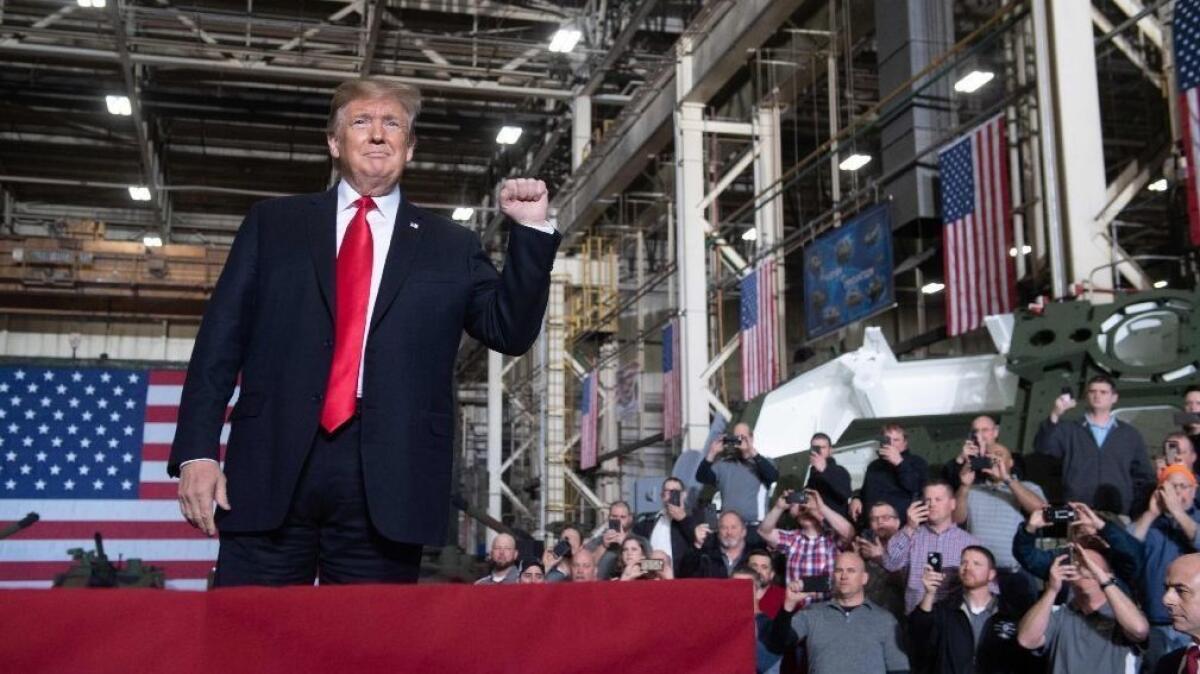Trump trumpets revival of manufacturing, but factory wages lag behind

However much credit President Trump may deserve, there’s no question that jobs in manufacturing — long the sick child of the U.S. economy — have turned up nicely since he took office.
What’s not so clear is how much good that surge has done for hundreds of thousands of American factory workers.
Wages for manufacturing have not kept up with other parts of the economy, a fact Trump avoids when he boasts across the nation’s heartland that he is fulfilling his promise to revitalize American industry. More recently, hiring at factories has slowed.
Manufacturing wage gains have lagged so much that, for the first time on record, the average hourly pay for all factory workers this year is less than for employees in service businesses, according to the Bureau of Labor Statistics.
The difference is small — $27.38 an hour for manufacturing versus $27.47 for service jobs, based on March data — but the gap nonetheless marks a striking reversal of historical trends and a further diminishing of the once-unquestioned idea that manufacturing was the surest ticket to economic security for workers.
“Once upon a time it was true — manufacturing was key to the middle class,” said Mark Zandi, chief economist at Moody’s Analytics. Today, that’s changed.
Decades of declining industrial jobs have contributed to stagnant wages, widening income disparity and economic malaise in smaller cities and rural communities — conditions that Trump has correctly identified. But in putting so much emphasis on manufacturing, Trump is making too much of a good thing, analysts say.
In addition to earnings lagging behind, the number of factory jobs today remains far behind the service sector. Manufacturing accounts for just 10% of overall private sector employment, down from 16% in 2000 and 25% in 1980.
There’s no going back, Zandi said. “We’ve got to focus on the services.”
To be sure, making things remains an important part of the American economy, especially high-tech goods. And those jobs still provide some of the best opportunities for workers without college degrees. But Trump’s focus on manufacturing could encourage workers — especially young people entering the labor market without advanced education—to overlook the greater opportunities they might have in the service sector, some analysts warn.
The Trump administration recently noted that total unfilled job openings now outnumber the total number of jobless Americans, whereas five years ago there were two unemployed persons for every job opening. That’s not so for blue-collar workers, however. Unemployed workers in manufacturing and construction still significantly outnumber job openings.
Why push people to where jobs are relatively scarce? asked Benn Steil, an economist at the Council on Foreign Relations, a nonpartisan think tank. He says the Trump administration could better help blue-collar workers by supporting their transition to services.
Manufacturing payrolls sank to about 11.5 million in 2010 thanks to the Great Recession, then started to climb back up before hitting a wall in 2015 and 2016. Factory employment has since risen by about 450,000 jobs — something Trump routinely brags about in speeches. (He said incorrectly on Saturday in Las Vegas that manufacturing was up 600,000 jobs since he was elected.)
Wage gains, however, have been scarce. Workers in industries such as metals and industrial machines have done well, but those employed at plants making motor vehicles, medical equipment, semiconductors, chemicals and pharmaceuticals, among others, have seen little or no gain in their hourly pay since early 2017.
Even when comparing total employment compensation — which includes healthcare and other benefits — manufacturing trails services in growth.
Economists say that’s partly because older, higher-paid manufacturing workers are retiring and being replaced by younger employees. There’s less unionization at factories and more two-tier contracts at shops in which new hires are coming in at lower rates. Some point to companies’ increasing use of temporary staff. Meanwhile, global competitive pressures have not let up.
Another big factor appears to be tied to productivity, which is key to lifting wages and living standards. Manufacturing productivity, typically measured as output per worker, has slowed in recent years. That’s probably tied to the aging population and relatively weaker investments in past years.
The White House says the big tax cut passed in late 2017, as well as the rollback of government regulations, has spurred corporate investments and should boost productivity. Yet at least some of those potential gains have been undercut by other administration measures, particularly Trump’s widespread use of tariffs.
Trump’s metal tariffs have protected domestic steel makers, but they have hurt a wider array of American manufacturers, chilling investment decisions and, in some cases, cutting into earnings that could have been used to give bigger raises.
Kawasaki Motors Manufacturing in Lincoln, Neb., employs about 2,000 people who make all-terrain vehicles, passenger railcars and other products. Business has been good for Kawasaki, and it has benefited from corporate tax cuts and an easing of environmental regulations.
But the president’s many tariffs have hurt Kawasaki in two ways: The plant uses a lot of steel, so the duties added to its costs. The indirect hit was worse.
Trump had threatened to ratchet up tariffs on some $200 billion of Chinese imports in March, prompting U.S. importers to place extra-large orders of Chinese goods to arrive before the higher duties take effect. Trump ended up putting off the increased tariffs, but by then, U.S. ports were already clogged with a deluge of Chinese products, delaying delivery of critical components for Kawasaki during its busiest season.
As a result, Kawasaki had to shut down its production for five working days in the first three months of this year. The episode shaved a hefty 7% from the company’s profits.
“Trying to use policies like tariffs to push workers into [manufacturing] industries is almost certainly self-defeating,” said Steil.
Trump now faces a weaker outlook for U.S. and global manufacturing, in part dimmed by trade uncertainties and softer economies in Europe and China. That will make it tougher for the president to trumpet his successes in Ohio, Michigan and other industrial states key to his reelection. Moreover, the nation’s trade deficit in goods has surged to a record high on his watch.
“We had a bit of a tailwind, but I do think things are slowing down,” said Jim Hodges, a former South Carolina governor who advises manufacturers and other firms in the state. In recent years, South Carolina has attracted global manufacturers such as BMW and Samsung. But for manufacturing on the whole, Hodges said, “you just haven’t seen as much in terms of wage increases.”
Apart from targeting domestic industries such as steel and military equipment makers, the Trump administration has supported manufacturing by enhancing apprenticeship programs. Yet at the same time, it has sought to cut funds for worker training.
Administration officials are counting on better trade deals, like its newly renegotiated North American Free Trade Agreement, to help keep more industrial jobs at home and bolster wages. But prospects for passage of the updated NAFTA are unclear in a divided Congress. So is a large-scale infrastructure spending measure that has been talked about and would bolster blue-collar jobs.
“I think it’s going to be a slog for manufacturing,” said Zandi, who’s expecting little factory job gains over the next two years. “The wind has been behind manufacturing’s back. And now it’s going to be in its face.”







